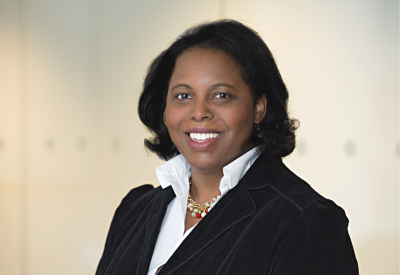When Karen Akinsanya, Ph.D., met for an interview, there was a palpable sense of both relief and excitement. A week earlier, on June 28, the head of R&D for Schrödinger’s new therapeutics wing had notched a major win—a green light from the FDA to start clinical trials with the company’s lead asset.
The drug, SGR-1505, is a MALT1 inhibitor to treat relapsed or refractory B-cell lymphoma that’s slated to start phase 1 in the second half of the year, potentially sometime in the third quarter.

But that feeling of achievement was somewhat stunted by a reality that tugs at virtually all biopharmas: The move into the clinic brings with it a fresh set of challenges. And for Schrödinger, which until now was focused squarely on drug discovery, it’s an extended leap into the unknown. Still, Akinsanya is bullish that the company is ready to jump in with both feet.
A former top scientist at Merck, Akinsanya moved over to Schrödinger more than four years ago to become chief biomedical scientist. But earlier this year, she was promoted to lead R&D for the company’s new therapeutics division as it builds out an internal pipeline of cancer therapies. Up to now, the company has passed the development baton to other biopharmas before a drug entered the clinic.
“What I met here was an enthusiasm to get it right,” she told Fierce Biotech, adding that being able to join a company that already has revenue and a project management foundation has made her job a bit easier.
In essence, Akinsanya is building out a brand-new wing of the more than 30-year-old company and designing a pipeline from scratch. That means figuring out what disease areas to focus on, what assets to pursue and how far the company intends to take the drugs it develops. In other words, Akinsanya has the financial backing of an industry staple and the infrastructure of a startup. But she’s aware that as a result of the company’s experience, she’s spending “Schrödinger money,” which inherently limits risk-taking, as opposed to new biotechs building pipelines that are funded by investors.
“We're also cognizant of the fact that doing a broad clinical development program—like going into phase 3—may not be the right set of activities,” said Akinsanya. “So what is it that we do with this program in order to prepare to partner with another Big Pharma?”
It was an illuminating comment. Here, Akinsanya was touting the significance of the moment while at the same time acknowledging that the company’s ambitions may not be to reach a commercial stage.
“What kind of trial is going to catch the attention of pharma companies?” she asked hypothetically. “And how far do we go in terms of cohort expansion and combination of studies for this mechanism? So yeah, we're really excited. We're in the thick of that right now.”
Akinsanya says there’s been growing excitement about the company’s lead program from other companies, both because of the unmet medical need but also due to the combination potential between SGR-1505 and other BTK inhibitors. But, as mentioned, the team isn’t itching for an early deal. The point of building out the clinical arm is to be able to accrue positive data, making the commercial value of assets and new drugs less of a shot in the dark and more likely.
It’s a strategy other platform-first companies are pursuing, including Insilico Medicine. The company originally focused solely on its AI-driven drug discovery program but has since expanded into the clinic to further validate the platform and grow value. CEO Alex Zhavoronkov, Ph.D., likens the process to precooking cookies.
Even as Schrödinger begins to invest in clinical work, Akinsanya underscored that the key to success remains its computational platform, which blends machine learning and predictive physics to discover new drugs. In the case of SGR-1505, it took just 10 months to discover a development candidate using the platform, one of the fastest timelines for the company to date. Akinsanya says the industry standard is approximately five years.
That speed has allowed the company to build a deep roster of programs—albeit the majority of which are for other partners—a tease of the potential therapeutic output should the company get into a clinical groove. The company is gearing up to submit a package of data to regulators in the second half of next year requesting that its second asset, CDC7 for hematological cancers and solid tumors, be allowed into the clinic as well.
But more than that, the platform provides a sturdy revenue base that gives Akinsanya, and Schrödinger, a bit more confidence as the company navigates a tumultuous bear market pummeling the biotech industry. As a result, Akinsanya cautions that the company will not rapidly switch to prioritizing its own assets.
“We don’t necessarily see the benefits from a rapid and aggressive pivot to exclusively wholly owned programs,” she said. “We see the opportunity to work on essentially—over the next five, 10 years—hundreds of programs.”